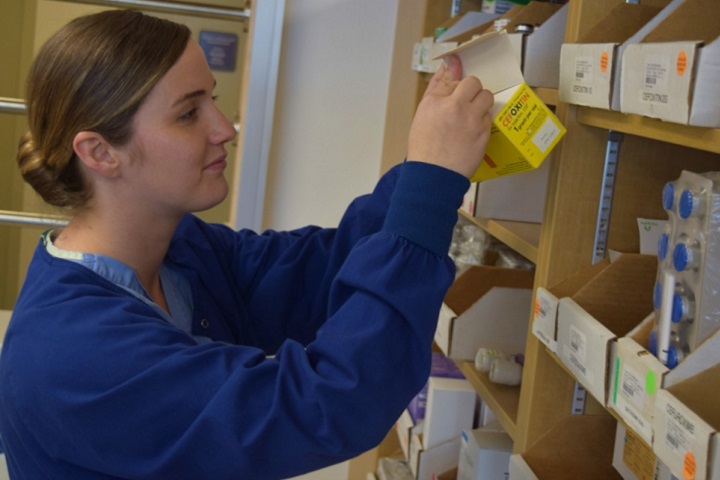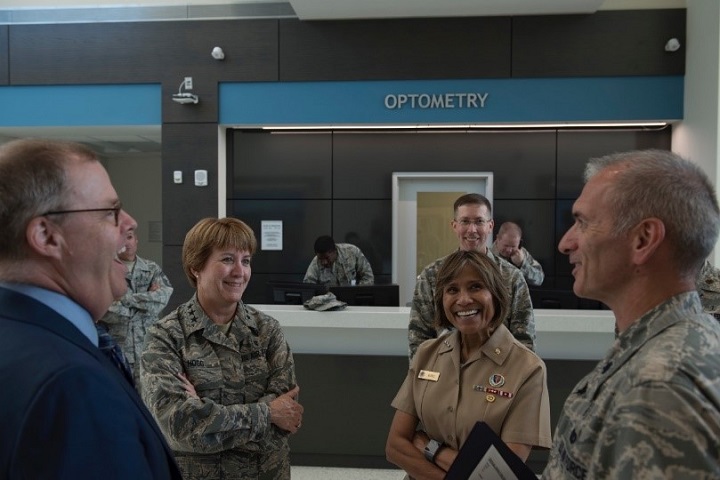
Robotics key to medical Airmen recruitment, retention, readiness

U.S. Air Force Maj. Scott Thallemer (foreground), 81st Surgical Operations Squadron Institute for Defense Robotic Surgical Education program coordinator, Keesler Air Force Base, Miss., and Air Force Maj. Joshua Tyler, InDoRSE program director, provide instruction to students during a robotics surgery training session at Keesler Air Force Base’s clinical research lab. (U.S. Air Force photo by Kemberly Groue)
FALLS CHURCH, Va. — With surgical robots becoming the standard of care across many specialties, the Air Force Medical Service is keeping up with the latest advancements to provide the best patient care and maintain Airman readiness.
“Robotics has been the standard for years in the private sector, especially in OB-GYN and urology,” said Air Force Maj. Joshua Tyler, director of robotics at Keesler Air Force Base, Mississippi. “The Air Force is bringing those same advancements in surgical robotics and technology that we see in the private sector into the hands of our surgeons and operating room medics.”
According to Tyler, getting this technology will improve patient care and have a positive impact on recruitment, retention and readiness. Having the opportunity to gain experience with surgical robotics enhances capabilities and skillsets.
“As a surgeon, robotics help me to see specific areas much clearer, especially in complex cases where millimeters matter,” said Tyler. “I have a better understanding of the tissue plane and what’s connected to what. Robotics help make me a better surgeon.”
Access to surgical robotics can also help surgeons treat a higher volume of patients, which also improves readiness.
“Robotics can bring more patients into our hospitals when we can now offer similar technology as the private sector,” said Tyler. “When surgeons treat more patients in their home station practice, they are more effective downrange.”
Surgical robotics helps retain seasoned and highly qualified surgeons in the Air Force. As Tyler explains, expanding opportunities for Air Force surgeons to have a rewarding clinical practice, leads to longer careers. This preserves vital institutional knowledge and ensures an active duty force with deployed medical experience.
“As we continue to improve our in-garrison surgical capabilities, we can help retain those valuable surgeons and ensure we are a far more ready medical force,” said Tyler.
The Air Force has already made significant strides in securing and expanding surgical robotics training opportunities. The 81st Medical Group at Keesler AFB stood-up its Institute for Defense Robotic Surgical Education program in March of 2017. The program has already trained 62 surgeons from 10 specialties and 29 facilities. InDoRSE graduates have gone on to perform nearly 740 robotics surgeries.
“InDoRSE has a unique focus with an emphasis on innovation and Trusted Care by training the entire surgical team to leverage their skills to deliver excellent care,” said Tyler.
Tyler, along with and the rest of Keesler’s InDoRSE robotics team, also helped to stand up the Air Force’s second robotic surgery program at Wright-Patterson AFB, Ohio, in April of last year. Air Force Maj. Toby Lees, the surgical specialties flight commander and urology medical director at Wright-Patterson AFB, is confident the program is improving readiness.
“The impact on medical Airmen and readiness is clear,” said Lees. “The tantalizing proposition is that one day a medic can get a patient to a hardened facility overseas, where a specialized surgeon could operate on them while at a center of excellence in the United States.”
According to Tyler, Nellis AFB, Nevada; Travis AFB, California; and Joint Base Andrews, Maryland facilities are set to acquire their own surgical robots.
“We are investing in our medical Airmen to give them new skills to stay on the cutting edge of medicine,” said Tyler. “Expanding our surgical robotics capabilities improves patient care while building the skills that keep Airmen ready to perform downrange.”
Disclaimer: Re-published content may have been edited for length and clarity. Read original post.
Cyberfit Poster: AirForce Family 2018
Poster
10/5/2018
This poster urges AirForce personnel to teach their children online safety.
Cyberfit Poster Think Twice 2018
Poster
10/5/2018
This poster urges military family members to think twice before posting something online.
Cyberfit Poster Guard Your Cell Phone 2018
Poster
10/5/2018
This poster urges military families to keep an eye on their cell phones, as anyone could take them, even their dog.
Cyberfit Poster Baby Monitor 2018
Poster
10/5/2018
This poster urges military families to make sure their baby monitors and home internet connection are properly secure.
Cyberfit Poster Navy Family 2018
Poster
10/5/2018
This poster urges Navy personnel to teach their children online safety.
Cyberfit Poster: Military Family Readiness 2018
Poster
10/5/2018
This poster urges military personnel to teach their children online safety.
Cyberfit Poster: Work with Kids 2018
Poster
10/5/2018
This poster urges military parents to make sure their families are CyberFit.
A 'Pharmacy Phamily' team effort recognized at Naval Hospital Bremerton
Article
10/3/2018

Naval Hospital Bremerton’s pharmacy selected for the 2018 Navy Pharmacy Team Award
DHA assumes management, administration of KMC
Article
10/2/2018

The Keesler Medical Center is the first hospital in the Air Force to transition
Air Force begins transition of hospitals, clinics to the Defense Health Agency
Article
10/2/2018

From a patient perspective, most of these changes should go unnoticed
Solution Delivery Division
Fact Sheet
10/2/2018
To deliver information technology solutions to the Military Health System through expert acquisition program management, process reengineering, information translation and sharing, training, and integration activities in order to support and advance the delivery of health care to our patients.
Implementing Congressional Direction for Reform of the Military Health System
Policy
Policy Memorandum, signed by Deputy Secretary of Defense Patrick M. Shanahan, to direct implementation of the Military Health System (MHS) organizational reform required by the National Defense Authorization Act.
- Identification #: N/A
- Date: 9/28/2018
- Type: Memorandums
- Topics: Military Hospitals and Clinics
DHA IPM 18-011: Video Network Center (VNC) Endpoint Standards
Policy
This Defense Health Agency-Interim Procedures Memorandum (DHA-IPM), based on the authority of References (a) through (c), and in accordance with the guidance of References (d) through (g): - Provides guidance for video network endpoint standards required for sites to connect to the Defense Health Agency (DHA) VNC network. These standards will help ensure security compliance, efficiency, and best practices are maintained across the DHA network. Meeting certification requirements brings many benefits, including: increased assurances of a successful video teleconference (VTC) experience, full access to bridge and point-to-point calls, and access to peer video networks, including the Department of Veterans Affairs, academia, and industry partners. Compliance with stated standards does not preclude users connecting to other DoD approved networks. - This DHA-IPM is effective immediately; it will be converted into a DHA-Procedural Instruction. This DHA-IPM will expire effective 12 months from the date of issue.
- Identification #: 18-011
- Date: 9/27/2018
- Type: DHA Interim Procedures Memorandum
- Topics: Technology
DHA IPM 18-008: Use of Medical Q Services (MQS) Contract by Military Treatment Facilities (MTFs)
Policy
This Defense Health Agency-Interim Procedures Memorandum (DHA-IPM), based on the authority of References (a) through (d): - Instructs MTFs and servicing contracting offices to use the DHA MQS contracts for the procurement of health care staffing requirements for market segments of physician, nurse, dental, and ancillary contract services in the United States and its Territories. - Is effective immediately; it must be incorporated into a forthcoming change to DHA Procedural Instruction 6025.05 (Reference (g)). This DHA-IPM will expire effective 12 months from the date of issue.
- Identification #: 18-008
- Date: 9/19/2018
- Type: DHA Interim Procedures Memorandum
- Topics: Military Hospitals and Clinics
DHA IPM 18-007: Service Delivery Management Program
Policy
This Defense Health Agency-Interim Procedures Memorandum (DHA-IPM), based on the authority of References (a) and (b), and in accordance with the guidance of References (c) through (e): - Establishes the Defense Health Agency’s (DHA) procedures for implementing and managing high quality information technology (IT) services by the Chief Information Officer (CIO), Deputy Assistant Director Information Operations (DAD IO/J-6), Military Health System (MHS). The DHA Service Delivery Management program provides customers requesting IT services from the DAD IO/J-6 or Defense Information Systems Agency service catalogs with an on-demand, automated system that provides a single-entry point to submit service requests. The automated system enables DAD IO/J-6 to align business needs and use repeatable and scalable processes to holistically track, manage, and report on customer submitted requests for IT services from submission to fulfillment. - Is binding on DoD Components and supports the Director’s, DHA, responsibility to develop appropriate management models to maximize efficiencies in the activities carried out by the DHA. - This DHA-IPM is effective immediately; it will be converted into a DHA-Procedural Instruction (DHA-PI). This DHA-IPM will expire effective 12 months from the date of issue.





















.png)









No hay comentarios:
Publicar un comentario